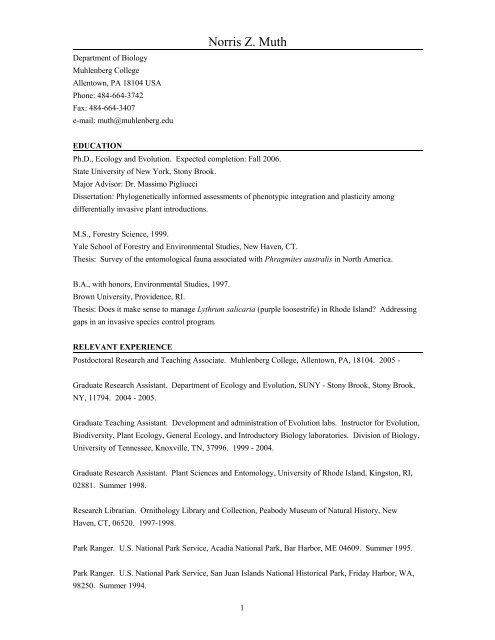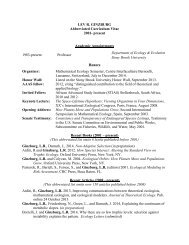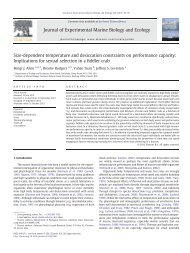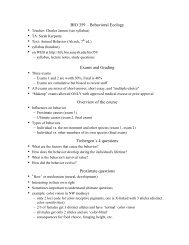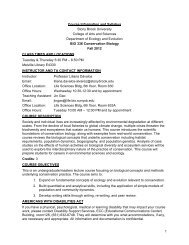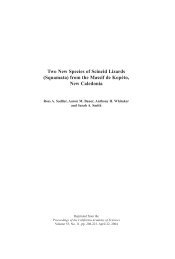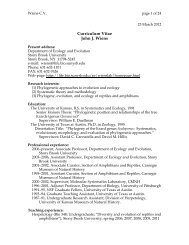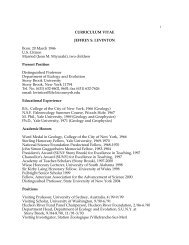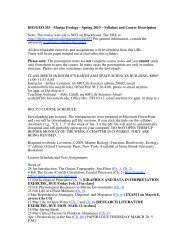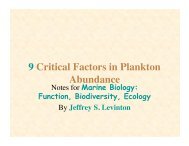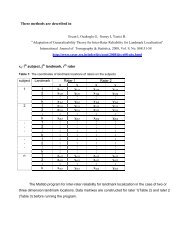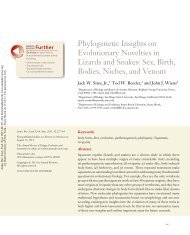Norris Z. Muth - Stony Brook University
Norris Z. Muth - Stony Brook University
Norris Z. Muth - Stony Brook University
You also want an ePaper? Increase the reach of your titles
YUMPU automatically turns print PDFs into web optimized ePapers that Google loves.
Department of Biology<br />
Muhlenberg College<br />
Allentown, PA 18104 USA<br />
Phone: 484-664-3742<br />
Fax: 484-664-3407<br />
e-mail: muth@muhlenberg.edu<br />
EDUCATION<br />
<strong>Norris</strong> Z. <strong>Muth</strong><br />
Ph.D., Ecology and Evolution. Expected completion: Fall 2006.<br />
State <strong>University</strong> of New York, <strong>Stony</strong> <strong>Brook</strong>.<br />
Major Advisor: Dr. Massimo Pigliucci<br />
Dissertation: Phylogenetically informed assessments of phenotypic integration and plasticity among<br />
differentially invasive plant introductions.<br />
M.S., Forestry Science, 1999.<br />
Yale School of Forestry and Environmental Studies, New Haven, CT.<br />
Thesis: Survey of the entomological fauna associated with Phragmites australis in North America.<br />
B.A., with honors, Environmental Studies, 1997.<br />
Brown <strong>University</strong>, Providence, RI.<br />
Thesis: Does it make sense to manage Lythrum salicaria (purple loosestrife) in Rhode Island? Addressing<br />
gaps in an invasive species control program.<br />
RELEVANT EXPERIENCE<br />
Postdoctoral Research and Teaching Associate. Muhlenberg College, Allentown, PA, 18104. 2005 -<br />
Graduate Research Assistant. Department of Ecology and Evolution, SUNY - <strong>Stony</strong> <strong>Brook</strong>, <strong>Stony</strong> <strong>Brook</strong>,<br />
NY, 11794. 2004 - 2005.<br />
Graduate Teaching Assistant. Development and administration of Evolution labs. Instructor for Evolution,<br />
Biodiversity, Plant Ecology, General Ecology, and Introductory Biology laboratories. Division of Biology,<br />
<strong>University</strong> of Tennessee, Knoxville, TN, 37996. 1999 - 2004.<br />
Graduate Research Assistant. Plant Sciences and Entomology, <strong>University</strong> of Rhode Island, Kingston, RI,<br />
02881. Summer 1998.<br />
Research Librarian. Ornithology Library and Collection, Peabody Museum of Natural History, New<br />
Haven, CT, 06520. 1997-1998.<br />
Park Ranger. U.S. National Park Service, Acadia National Park, Bar Harbor, ME 04609. Summer 1995.<br />
Park Ranger. U.S. National Park Service, San Juan Islands National Historical Park, Friday Harbor, WA,<br />
98250. Summer 1994.<br />
1
GRANTS AND AWARDS<br />
Science Alliance Graduate Student Teaching Award. 2003.<br />
Ecology and Evolutionary Biology Research Award. 2002 and 2003.<br />
Survey of the entomological fauna associated with Phragmites australis in North America. Connecticut Sea<br />
Grant Student Internship. 1999.<br />
Crown-Zellerbach Graduate Fellowship, 1998.<br />
Effects of landscape structure on parasitism of the birch leafminer (Fenusa pusilla). A.V. Stout Fund.<br />
1998.<br />
Efficacy and ecological implications of purple loosestrife (Lythrum salicaria) management in Rhode Island.<br />
Brown <strong>University</strong> Undergraduate Teaching and Research Award. 1996.<br />
REFEREED PUBLICATIONS<br />
*Skoczylas, D., <strong>Muth</strong>, N.Z., and Niesenbaum, R.A. In Prep. Top down control of herbivory on Lindera<br />
benzoin by insectivorous avifauna.<br />
<strong>Muth</strong>, N.Z. and Pigliucci, M. In Prep. Patterns of phenotypic integration among invasive and non-invasive<br />
plant introductions.<br />
<strong>Muth</strong>, N.Z., Kluger, E.C., *Levy, J., Ingersoll, M.C., Edwards, M.J., and Niesenbaum, R.A. In Review.<br />
Herbivory of Lindera benzoin L. (Lauraceae) mediated by light quality induced differences in leaf quality<br />
and defense.<br />
<strong>Muth</strong>, N.Z. and Pigliucci, M. In Review. Implementation of a novel framework for assessing phenotypic<br />
plasticity in introduced species: responses of Centaurea and Crepis to phosphorus and water availability.<br />
Richards, C.L., Bossdorf, O., <strong>Muth</strong>, N.Z., Gurevitch, J, and Pigliucci, M. 2006. Jack of all trades, master of<br />
some? On the role of phenotypic plasticity in plant invasions. Ecology Letters. 9 : 981-993.<br />
<strong>Muth</strong>, N.Z. and Pigliucci, M. 2006. Traits of invasives reconsidered: phenotypic comparisons of introduced<br />
invasive and introduced non-invasive plant species within two closely related clades. American Journal of<br />
Botany. 93(2) : 188-195.<br />
Weltzin, J.F., <strong>Muth</strong>, N.Z., Von Holle, B. and Cole, P.G. 2003. Genetic diversity and invasibility: a test<br />
using a model system with a novel experimental design. Oikos. 103: 505–518.<br />
<strong>Muth</strong>, N.Z. and Hamburg, S.P. 1998. Addressing purple loosestrife management in Rhode Island.<br />
Northeastern Naturalist. 5(1): 67-74.<br />
*indicates undergraduate student author<br />
2
OTHER PUBLICATIONS<br />
<strong>Muth</strong>, N.Z. and Pigliucci, M. 2005. Using invasive species biology to teach about evolution. in<br />
Evolutionary Science and Society: Educating a New Generation. Cracraft, J. and R. Bybee (eds.).<br />
Biological Sciences Curriculum Study, Colorado Springs, CO.<br />
Pigliucci, M., Banta, J., Bossu, C., Crouse, P., Dexter, T., Hansknecht, and <strong>Muth</strong>, N. 2004. The alleged<br />
fallacies of evolutionary theory. Philosophy now. 46 : 36-39.<br />
<strong>Muth</strong>, N.Z. 2003. Gene flow might turn wimps into superweeds. Nature. 421: 785-786.<br />
Vazquez, D.P, McMahon, S.M., <strong>Muth</strong>, N.Z., and Collins, M.D. 2002. Book Review; The unified neutral<br />
theory of biodiversity and biogeography. Journal of Experimental Marine Biology and Ecology. 269: 249-<br />
250.<br />
<strong>Muth</strong>, N.Z. 1997. Does it make sense to manage Lythrum salicaria (purple loosestrife) in Rhode Island?<br />
Addressing gaps in an invasive species control program. B.A. Honors Thesis, Brown <strong>University</strong>.<br />
SERVICE<br />
2005. Judge, Long Island Science & Engineering Fair.<br />
2005. Discussion Moderator, Darwin Day, SUNY – <strong>Stony</strong> <strong>Brook</strong>.<br />
2003. Faculty search committee member, <strong>University</strong> of Tennessee, Department of Ecology and<br />
Evolutionary Biology.<br />
2002 - 2004. Treasurer, Tennessee Darwin Coalition.<br />
2001 - 2002. President, Graduate Researchers in Ecology, Behavior and Evolution.<br />
2001. Teacher of the Year Selection Committee Member, <strong>University</strong> of Tennessee National Alumni<br />
Association.<br />
2001. Volunteer event assistant: Kids' <strong>University</strong>.<br />
2000 - 2002. Volunteer event coordinator: Tennessee Science Olympics.<br />
2000 - 2001. Graduate Student Association, departmental representative. <strong>University</strong> of Tennessee,<br />
Department of Ecology and Evolutionary Biology.<br />
2000 - 2006. Regional alumni interviewer, Brown Alumni Schools Committee.<br />
1998 - 1999. Officer, Society for Conservation Biology, Yale <strong>University</strong>, student chapter.<br />
3
PRESENTATION ABSTRACTS<br />
<strong>Muth</strong>, N.Z. and Niesenbaum, R.A. 2006. Reduced herbivory of Lindera benzoin growing in proximity to<br />
Juglans nigra: associational resistance mediated by an allelopathic compound? Ecological Society of<br />
America.<br />
Irwin, B., Niesenbaum, R.A., and <strong>Muth</strong>, N.Z. 2006. Volatile chemistry, rates of parasitism of herbivores,<br />
and rates of herbivory on Lindera benzoin vary with light environment. Ecological Society of America.<br />
<strong>Muth</strong>, N.Z. and Niesenbaum, R.A. 2006. Where is spicebush the spiciest? Making sense of variation in<br />
leaf quality, chemistry, and herbivory in Lindera benzoin. Lehigh Valley Evolution and Ecology<br />
Symposium.<br />
<strong>Muth</strong>, N.Z. and Pigliucci, M. 2005. Empirical study and general models of phenotypic plasticity in<br />
introduced invasive and introduced non-invasive species. Northeast Ecology and Evolution Conference.<br />
<strong>Muth</strong>, N.Z. and Pigliucci, M. 2004. Using evolution to combat invasive species. Annual convention<br />
National Association of Biology Teachers.<br />
<strong>Muth</strong>, N.Z. and Pigliucci, M. 2004. The importance of phenotypic plasticity and phylogeny in<br />
understanding introduced invasives. Annual meeting of the Society for the Study of Evolution.<br />
<strong>Muth</strong>, N.Z. and Pigliucci, M. 2002. Effects of phylogeny and introduction on patterns of invasiveness.<br />
Annual meeting of the Society for the Study of Evolution.<br />
<strong>Muth</strong>, N.Z. and Pigliucci, M. 2002. Importance of controlling for phylogeny and introduction status in<br />
invasion studies. Annual meeting of the Southeast Ecology and Population Genetics Group.<br />
Fukami, T., Zimmermann, C. R., <strong>Muth</strong>, N. Z. and Drake, J. A. 2000. An experimentally-derived community<br />
assembly map. Annual Meeting of the Ecological Society of America.<br />
INVITED SEMINARS<br />
2006. Biology Department, Muhlenberg College.<br />
2003. Department of Biology, City <strong>University</strong> of New York, <strong>Brook</strong>lyn College.<br />
2003. Knoxville Technical Society.<br />
2001. <strong>University</strong> of Tennessee, Evolutionary and Behavioral Ecology seminar series.<br />
2001. Pellissippi State Technical Community College, Department of Natural and Behavioral Sciences.<br />
4
STUDENTS MENTORED<br />
Kim Kennard. Assessments of phenotypic integration in invasive plant introductions. Currently: doctoral<br />
student, Department of Ecology and Evolutionary Biology, <strong>University</strong> of Tennessee, Knoxville, TN.<br />
Jennifer Levy. Variation in Lindera benzoin leaf toughness, quality, and chemistry with respect to light<br />
environment. Currently: doctoral student, Department of Earth and Environmental Sciences, Columbia<br />
<strong>University</strong>, New York, NY.<br />
Daniel Skoczylas. Top down control of herbivory on Lindera benzoin by insectivorous avifauna.<br />
Department of Entomology, Washington State <strong>University</strong>, Pullman, WA.<br />
Jon Paul Plumlee. Assessments of phenotypic plasticity in invasive plant introductions. <strong>University</strong> of<br />
Tennessee, Knoxville, TN.<br />
Nadine Goldman. Analytical chemistry techniques for assessing variation in secondary chemistry of<br />
Lindera benzoin. Muhlenberg College, Allentown, PA.<br />
Beth Irwin. Volatile chemistry, rates of parasitism, and rates of herbivory vary with light environment.<br />
Muhlenberg College, Allentown, PA.<br />
Angela Lucarini. Effects of juglone concentration on soil pupating lepidopteran herbivores. Muhlenberg<br />
College, Allentown, PA.<br />
Jessica Rodriguez. Analytical chemistry techniques for assessing leaf quality variation in Lindera benzoin.<br />
Muhlenberg College, Allentown, PA.<br />
5


